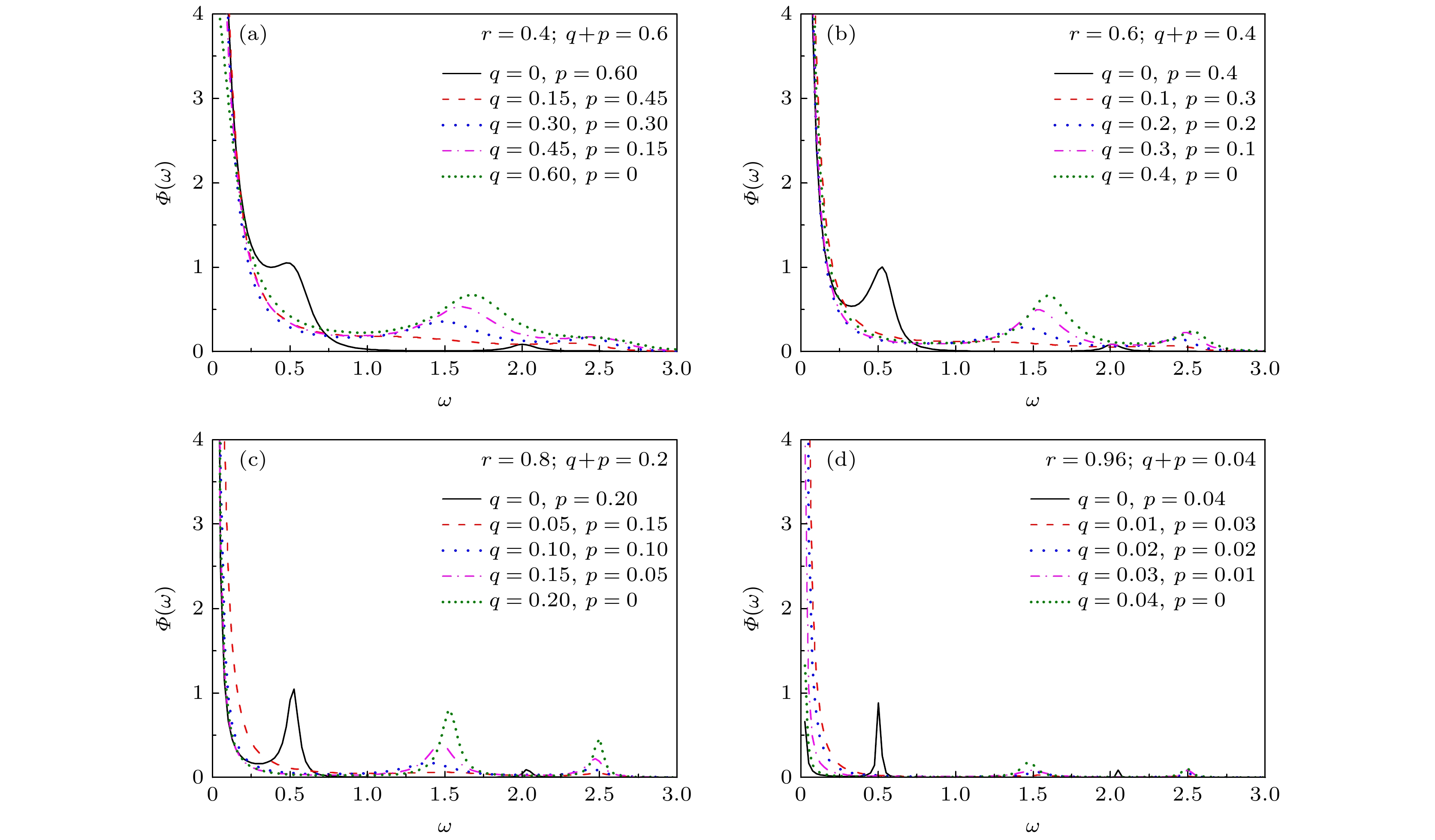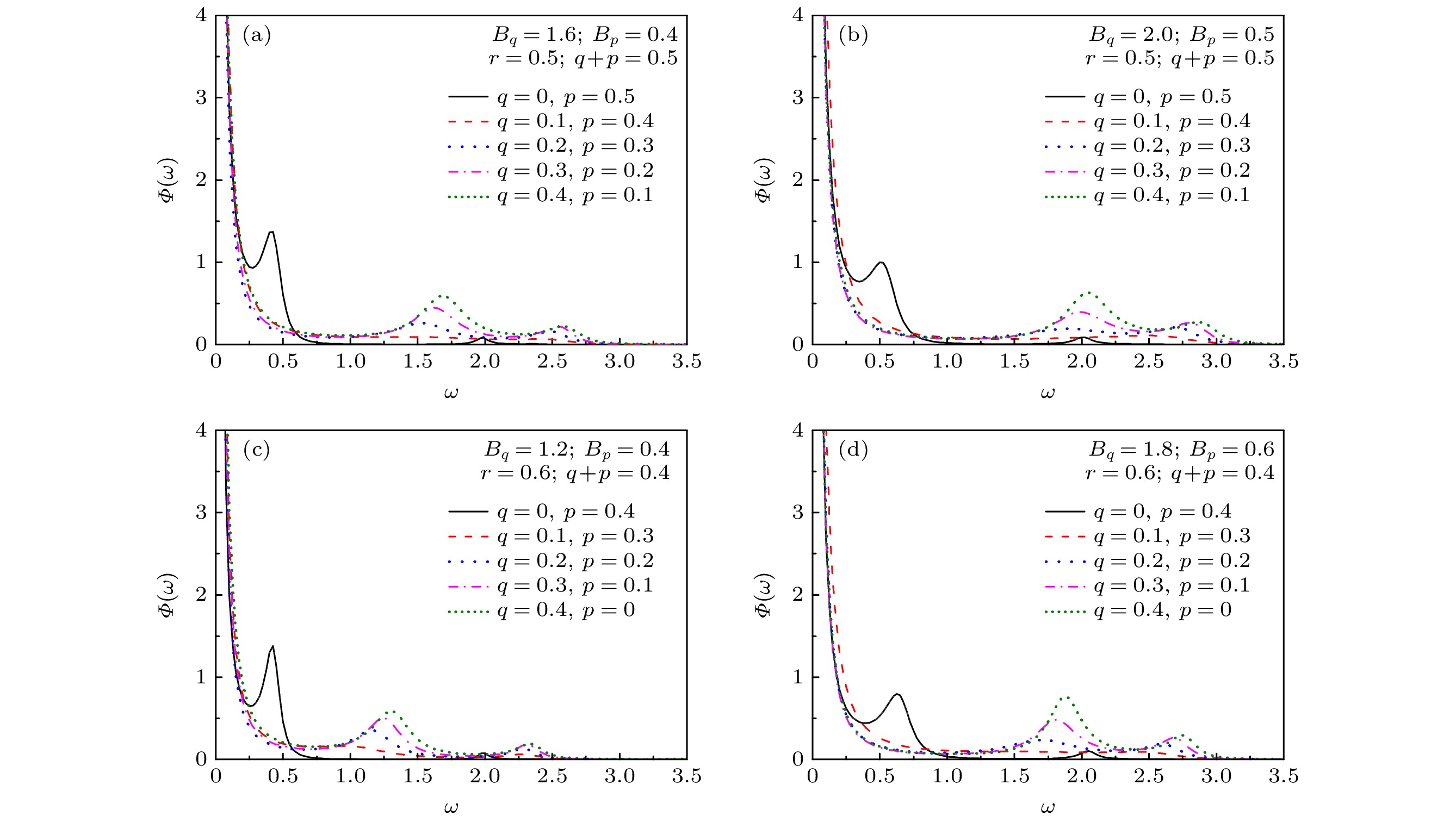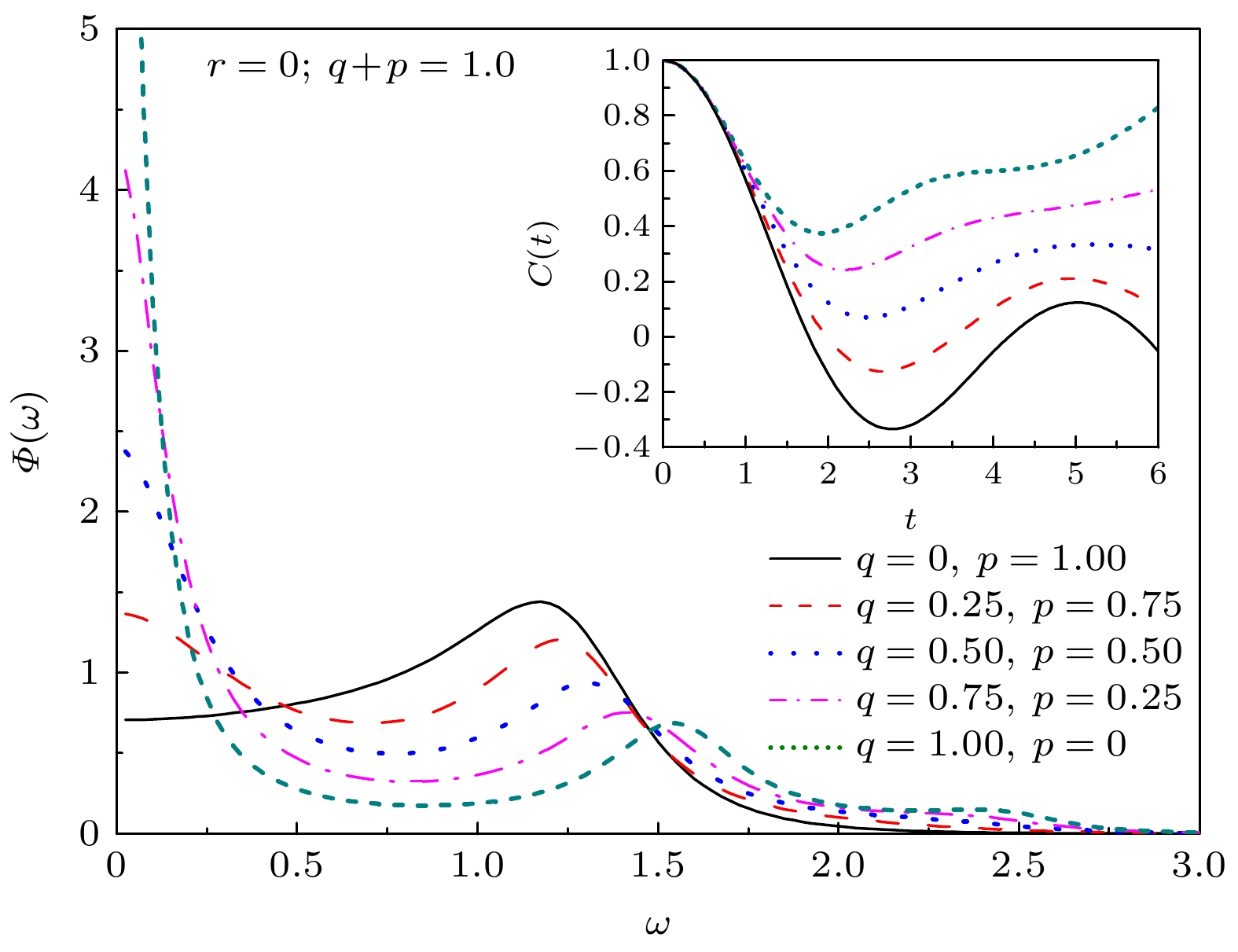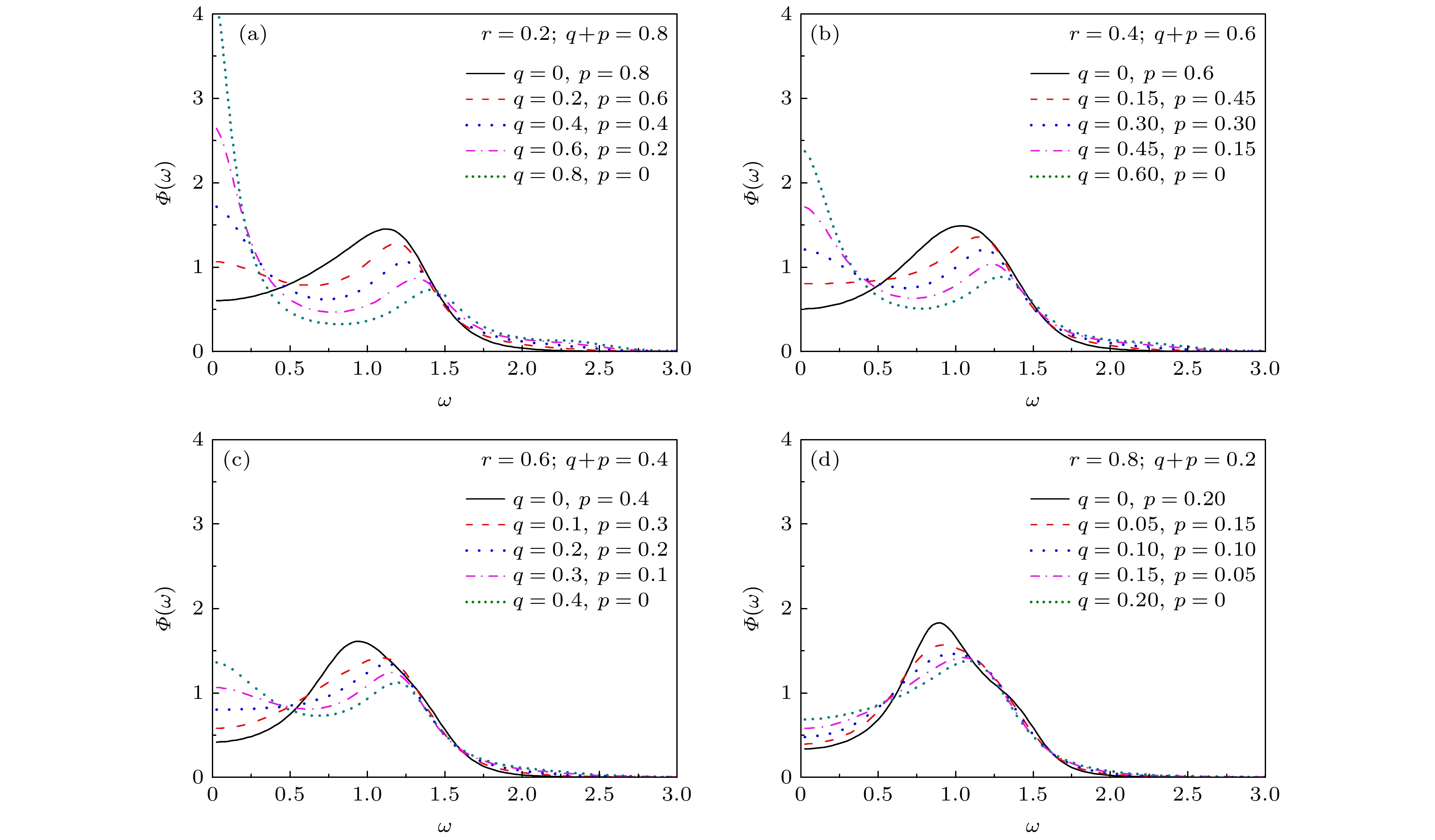-
量子自旋系统在外磁场下的动力学性质一直是凝聚态理论和统计物理研究的热点. 本文利用递推关系方法, 通过计算系统的自旋关联函数及其对应的谱密度, 研究了三模型随机外场对一维量子Ising模型动力学性质的调控效应. 在三模型随机横场下, 利用r分支引入了非磁性杂质, 研究表明: 非磁性杂质使得系统的低频响应得到保持, 中心峰值行为更加明显; 非磁性杂质与横场之间的竞争能激发出新的频率响应, 呈现多峰行为; 但较多的非磁性杂质最终会限制系统对横场的响应. 此外, 研究还发现随机横场的三模分布参数满足
$ q{B_q} = p{B_p} $ 这一条件, 是使中心峰值行为得到保持的有利条件. 在三模型随机纵场下, r分支仅仅起到调节纵场强度的作用, 且r分支所占比重的增大不利于低频响应, 与三模型随机横场下r分支的调控作用是相反的.It is of fundamental importance to know the dynamics of quantum spin systems immersed in external magnetic fields. In this work, the dynamical properties of one-dimensional quantum Ising model with trimodal random transverse and longitudinal magnetic fields are investigated by the recursion method. The spin correlation function $C\left( t \right) = \overline {\left\langle {\sigma _j^x\left( t \right)\sigma _j^x\left( 0 \right)} \right\rangle } $ and the corresponding spectral density$\varPhi \left( \omega \right) = \displaystyle\int_{ - \infty }^{ + \infty } {{\rm{d}}t{{\rm{e}}^{{\rm{i}}\omega t}}C\left( t \right)}$ are calculated. The model Hamiltonian can be written as$ H = - \dfrac{1}{2}J\displaystyle\sum\limits_i^N {\sigma _i^x\sigma _{i + 1}^x} - \dfrac{1}{2}\displaystyle\sum\limits_i^N {{B_{iz}}\sigma _i^z} - \dfrac{1}{2}\sum\limits_i^N {{B_{ix}}\sigma _i^x} $ ,where $\sigma _i^\alpha \left( {\alpha = x,y,z} \right)$ are Pauli matrices at site$ i $ ,$J$ is the nearest-neighbor exchange coupling.$ {B_{iz}} $ and$ {B_{ix}} $ denote the transverse and longitudinal magnetic field, respectively. They satisfy the following trimodal distribution,$ \rho \left( {{B_{iz}}} \right) = p\delta ({B_{iz}} - {B_p}) + q\delta ({B_{iz}} - {B_q}) + r\delta ({B_{iz}}) $ ,$ \rho \left( {{B_{ix}}} \right) = p\delta ({B_{ix}} - {B_p}) + q\delta ({B_{ix}} - {B_q}) + r\delta ({B_{ix}}). $ The value intervals of the coefficients $p$ ,$q$ and$r$ are all [0,1], and the coefficients satisfy the constraint condition$ p + q + r = 1 $ .For the case of trimodal random $ {B_{iz}} $ (consider$ {B_{ix}} \equiv 0 $ for simplicity), the exchange couplings are assumed to be$J \equiv 1$ to fix the energy scale, and the reference values are set as follows:$ {B_p} = 0.5 < J $ and$ {B_q} = 1.5 > J $ . The coefficient$r$ can be considered as the proportion of non-magnetic impurities. When$r = 0$ , the trimodal distribution reduces into the bimodal distribution. The dynamics of the system exhibits a crossover from the central-peak behavior to the collective-mode behavior as$q$ increases, which is consistent with the value reported previously. As$r$ increases, the crossover between different dynamical behaviors changes obviously (e.g. the crossover from central-peak to double-peak when$r = 0.2$ ), and the presence of non-magnetic impurities favors low-frequency response. Owing to the competition between the non-magnetic impurities and transverse magnetic field, the system tends to exhibit multi-peak behavior in most cases, e.g.$r = 0.4$ , 0.6 or 0.8. However, the multi-peak behavior disappears when$r \to 1$ . That is because the system's response to the transverse field is limited when the proportion of non-magnetic impurities is large enough. Interestingly, when the parameters satisfy$ q{B_q} = p{B_p} $ , the central-peak behavior can be maintained. What makes sense is that the conclusion is universal.For the case of trimodal random $ {B_{ix}} $ , the coefficient$r$ no longer represents the proportion of non-magnetic impurities when$ {B_{ix}} $ and$ {B_{iz}} $ ($ {B_{iz}} \equiv 1 $ ) coexist here. In the case of weak exchange coupling, the effect of longitudinal magnetic field on spin dynamics is obvious, so$J \equiv 0.5$ is set here. The reference values are set below:$ {B_p} = 0.5 \lt {B_{iz}} $ and$ {B_q} = 1.5 \gt {B_{iz}} $ . When$r$ is small ($r = 0$ , 0.2 or 0.4), the system undergoes a crossover from the collective-mode behavior to the double-peak behavior as$q$ increases. However, the low-frequency responses gradually disappear, while the high-frequency responses are maintained as$r$ increases. Take the case of$ r = 0.8 $ for example, the system only presents a collective-mode behavior. The results indicate that increasing$r$ is no longer conducive to the low-frequency response, which is contrary to the case of trimodal random$ {B_{iz}} $ . The$r$ branch only regulates the intensity of the trimodal random$ {B_{ix}} $ . Our results indicate that using trimodal random magnetic field to manipulate the spin dynamics of the Ising system may be a new try.-
Keywords:
- Ising model /
- trimodal distribution /
- spin correlation function /
- spectral density
[1] Kenzelmann M, Coldea R, Tennant D A, Visser D, Hofmann M, Smeibidl P, Tylczynski Z 2002 Phys. Rev. B 65 144432
 Google Scholar
Google Scholar
[2] Zhao Z Y, Liu X G, He Z Z, Wang X M, Fan C, Ke W P, Li Q J, Chen L M, Zhao X, Sun X F 2012 Phys. Rev. B 85 134412
 Google Scholar
Google Scholar
[3] Cui Y, Zou H, Xi N, He Z, Yang Y X, Shu L, Zhang G H, Hu Z, Chen T, Yu R, Wu J and Yu W 2019 Phys. Rev. Lett. 123 067203
 Google Scholar
Google Scholar
[4] Simon J, Bakr W S, Ma R, Tai M E, Preiss P M, Greiner M 2011 Nature 472 307
 Google Scholar
Google Scholar
[5] Dmitriev D V, Krivnov V Y 2004 Phys. Rev. B 70 144414
 Google Scholar
Google Scholar
[6] Neto M A, De Sousa J R 2013 Physica A 392 1
 Google Scholar
Google Scholar
[7] Corrêa Silva E V, Skea J E F, Rojas O, De Souza S M, Thomaz M T 2008 Physica A 387 5117
 Google Scholar
Google Scholar
[8] Do Nascimento D A, Neto M A, De Sousa J R, Pacobahyba J T 2012 J. Magn. Magn. Mater. 324 2429
 Google Scholar
Google Scholar
[9] Do Nascimento D A, Pacobahyba J T, Neto M A, Salmon O D R, Plascak J A 2017 Physica A 474 224
 Google Scholar
Google Scholar
[10] Senthil T 1998 Phys. Rev. B 57 8375
 Google Scholar
Google Scholar
[11] Liu Z Q, Jiang S R, Kong X M, Xu Y L 2017 Physica A 473 536
 Google Scholar
Google Scholar
[12] Florencio J, Sá Barreto F C 1999 Phys. Rev. B 60 9555
 Google Scholar
Google Scholar
[13] Chen S X, Shen Y Y, Kong X M 2010 Phys. Rev. B 82 174404
 Google Scholar
Google Scholar
[14] Da Conceição C M S, Maia R N P 2017 Phys. Rev. E 96 032121
[15] von Ohr S, Manssen M, Hartmann A K 2017 Phys. Rev. E 96 013315
 Google Scholar
Google Scholar
[16] Liu Z Q, Kong X M, Chen X S 2006 Phys. Rev. B 73 224412
 Google Scholar
Google Scholar
[17] Theodorakis P E, Georgiou I, Fytas N G 2013 Phys. Rev. E 87 032119
 Google Scholar
Google Scholar
[18] Crokidakis N, Nobre F D 2008 J. Phys. Condens. Matter 20 145211
 Google Scholar
Google Scholar
[19] Liu Z Q, Jiang S R, Kong X M 2014 Chin. Phys. B 23 087505
 Google Scholar
Google Scholar
[20] Hadjiagapiou I A 2011 Physica A 390 2229
 Google Scholar
Google Scholar
[21] Hadjiagapiou I A, Velonakis I N 2018 Physica A 505 965
 Google Scholar
Google Scholar
[22] Hadjiagapiou I A, Velonakis I N 2021 Physica A 578 126112
 Google Scholar
Google Scholar
[23] Kaufman M, Klunzinger P E, Khurana A 1986 Phys. Rev. B 34 4766
 Google Scholar
Google Scholar
[24] Saxena V K 1987 Phys. Rev. B 35 2055
 Google Scholar
Google Scholar
[25] Hadjiagapiou I A, Velonakis I N 2019 Physica A 534 122065
 Google Scholar
Google Scholar
[26] Mattis D C 1985 Phys. Rev. Lett. 55 3009
 Google Scholar
Google Scholar
[27] Sebastianes R M, Saxena V K 1987 Phys. Rev. B 35 2058
 Google Scholar
Google Scholar
[28] Fogedby H C 1978 J. Phys. C Solid State Phys. 11 2801
 Google Scholar
Google Scholar
[29] Kopeć T K, Usadel K D, Büttner G 1989 Phys. Rev. B 39 12418
 Google Scholar
Google Scholar
[30] Ovchinnikov A A, Dmitriev D V, Krivnov V Y, Cheranovskii V O 2003 Phys. Rev. B 68 214406
 Google Scholar
Google Scholar
[31] Yuan X J, Zhao J F, Wang H, Bu H X, Yuan H M, Zhao B Y, Kong X M 2021 Physica A 583 126279
 Google Scholar
Google Scholar
[32] Viswanath V S, Müller G 1994 The Recursion Method—Application to Many-body Dynamics (Berlin: Springe-Verlag)
[33] Mezei F, Murani A P 1979 J. Magn. Magn. Mater. 14 211
 Google Scholar
Google Scholar
[34] Lee M H 1982 Phys. Rev. Lett. 49 1072
 Google Scholar
Google Scholar
[35] Lee M H 1982 Phys. Rev. B 26 2547
 Google Scholar
Google Scholar
[36] Lee M H 2000 Phys. Rev. E 62 1769
 Google Scholar
Google Scholar
[37] Florencio J, De Alcantara Bonfim O F 2020 Front. Phys. 8 557277
 Google Scholar
Google Scholar
[38] 袁晓娟, 王辉, 赵邦宇, 赵敬芬, 明静, 耿延雷, 张凯煜 2021 物理学报 70 197501
 Google Scholar
Google Scholar
Yuan X J, Wang H, Zhao B Y, Zhao J F, Ming J, Geng Y L, Zhang K Y 2021 Acta Phys. Sin. 70 197501
 Google Scholar
Google Scholar
-
图 1 (a), (b)
$ r \equiv 0 $ 时的自旋关联函数$C\left( t \right)$ 及相应的谱密度$ \varPhi \left( \omega \right) $ ; (c), (d)$ r = 0.2 $ 时的$C\left( t \right)$ 及$ \varPhi \left( \omega \right) $ . 三模分布中的参数$ {B_p} = 0.5 $ ,$ {B_q} = 1.5 $ Fig. 1. The spin autocorrelation function
$C\left( t \right)$ and corresponding spectral density$ \varPhi \left( \omega \right) $ for$ r \equiv 0 $ are given in graphs (a) and (b), and for$ r = 0.2 $ are given in graphs (c) and (d), respectively. The parameters$ {B_p} $ and$ {B_q} $ in the tri-modal distribution are 0.5 and 1.5, respectively.图 3 随机选取几组参数, 给出不同参数下的谱密度 (a)
$ r = 0.5 $ ,$ {B_q} = 1.6 $ ,$ {B_p} = 0.4 $ ; (b)$ r = 0.5 $ ,$ {B_q} = 2.0 $ ,$ {B_p} = 0.5 $ ; (c)$ r = 0.6 $ ,$ {B_q} = 1.2 $ ,$ {B_p} = 0.4 $ ; (d)$ r = 0.6 $ ,$ {B_q} = 1.8 $ ,$ {B_p} = 0.6 $ . (a)—(d) 中红色虚线对应的参数满足$ q{B_q} = p{B_p} $ Fig. 3. The spectral densities for several groups of parameters: (a)
$ r = 0.5 $ ,$ {B_q} = 1.6 $ ,$ {B_p} = 0.4 $ ; (b)$ r = 0.5 $ ,$ {B_q} = 2.0 $ ,$ {B_p} = 0.5 $ ; (c)$ r = 0.6 $ ,$ {B_q} = 1.2 $ ,$ {B_p} = 0.4 $ ; (d)$ r = 0.6 $ ,$ {B_q} = 1.8 $ ,$ {B_p} = 0.6 $ . The parameters corresponding to the red dashed lines in graphs (a)–(d) satisfy$ q{B_q} = p{B_p} $ .图 4 (a)图3(c)所给参数下的连分式系数
${\varDelta _1}, {\varDelta _2}, \cdots , {\varDelta _9}$ , 仅给出了$ q \ne 0 $ 且$ p \ne 0 $ 时的结果, 参数取值为$ r = 0.6 $ ,$ {B_q} = 1.2 $ ,$ {B_p} = 0.4 $ ; (b)—(d)$ q = 0.1 $ , 0.2, 0.3时连分式系数线性拟合的结果Fig. 4. (a) The first nine recurrents
${\varDelta _1}, {\varDelta _2}, \cdots , {\varDelta _9}$ for the parameters$ r = 0.6 $ ,$ {B_q} = 1.2 $ and$ {B_p} = 0.4 $ given in Fig. 3(c); (b)–(d) the linear fit results of the recurrents for$ q = 0.1 $ , 0.2 and 0.3, respectively.图 5 三模型随机纵场蜕化为双模型随机纵场时的谱密度和自旋关联函数(插图), 三模分布系数
$ r = 0 $ , 参数$ {B_p} = 0.5 $ ,$ {B_q} = 1.5 $ Fig. 5. Spectral density and spin autocorrelation function for trimodal-type random longitudinal magnetic field when
$ r = 0 $ . The inset is the corresponding result of$C\left( t \right)$ . The parameters$ {B_p} $ and$ {B_q} $ in the tri-modal distribution are 0.5 and 1.5, respectively.图 6 随机纵场满足三模分布时的谱密度 (a)—(d)系数
$ r = 0.2 $ , 0.4, 0.6, 0.8. 三模分布中的参数$ {B_p} = 0.5 $ ,$ {B_q} = 1.5 $ Fig. 6. Spectral densities for tri-modal-type random longitudinal magnetic field: (a)–(d)
$ r = 0.2 $ , 0.4, 0.6, 0.8. The parameters$ {B_p} $ and$ {B_q} $ in the tri-modal distribution are 0.5 and 1.5, respectively. -
[1] Kenzelmann M, Coldea R, Tennant D A, Visser D, Hofmann M, Smeibidl P, Tylczynski Z 2002 Phys. Rev. B 65 144432
 Google Scholar
Google Scholar
[2] Zhao Z Y, Liu X G, He Z Z, Wang X M, Fan C, Ke W P, Li Q J, Chen L M, Zhao X, Sun X F 2012 Phys. Rev. B 85 134412
 Google Scholar
Google Scholar
[3] Cui Y, Zou H, Xi N, He Z, Yang Y X, Shu L, Zhang G H, Hu Z, Chen T, Yu R, Wu J and Yu W 2019 Phys. Rev. Lett. 123 067203
 Google Scholar
Google Scholar
[4] Simon J, Bakr W S, Ma R, Tai M E, Preiss P M, Greiner M 2011 Nature 472 307
 Google Scholar
Google Scholar
[5] Dmitriev D V, Krivnov V Y 2004 Phys. Rev. B 70 144414
 Google Scholar
Google Scholar
[6] Neto M A, De Sousa J R 2013 Physica A 392 1
 Google Scholar
Google Scholar
[7] Corrêa Silva E V, Skea J E F, Rojas O, De Souza S M, Thomaz M T 2008 Physica A 387 5117
 Google Scholar
Google Scholar
[8] Do Nascimento D A, Neto M A, De Sousa J R, Pacobahyba J T 2012 J. Magn. Magn. Mater. 324 2429
 Google Scholar
Google Scholar
[9] Do Nascimento D A, Pacobahyba J T, Neto M A, Salmon O D R, Plascak J A 2017 Physica A 474 224
 Google Scholar
Google Scholar
[10] Senthil T 1998 Phys. Rev. B 57 8375
 Google Scholar
Google Scholar
[11] Liu Z Q, Jiang S R, Kong X M, Xu Y L 2017 Physica A 473 536
 Google Scholar
Google Scholar
[12] Florencio J, Sá Barreto F C 1999 Phys. Rev. B 60 9555
 Google Scholar
Google Scholar
[13] Chen S X, Shen Y Y, Kong X M 2010 Phys. Rev. B 82 174404
 Google Scholar
Google Scholar
[14] Da Conceição C M S, Maia R N P 2017 Phys. Rev. E 96 032121
[15] von Ohr S, Manssen M, Hartmann A K 2017 Phys. Rev. E 96 013315
 Google Scholar
Google Scholar
[16] Liu Z Q, Kong X M, Chen X S 2006 Phys. Rev. B 73 224412
 Google Scholar
Google Scholar
[17] Theodorakis P E, Georgiou I, Fytas N G 2013 Phys. Rev. E 87 032119
 Google Scholar
Google Scholar
[18] Crokidakis N, Nobre F D 2008 J. Phys. Condens. Matter 20 145211
 Google Scholar
Google Scholar
[19] Liu Z Q, Jiang S R, Kong X M 2014 Chin. Phys. B 23 087505
 Google Scholar
Google Scholar
[20] Hadjiagapiou I A 2011 Physica A 390 2229
 Google Scholar
Google Scholar
[21] Hadjiagapiou I A, Velonakis I N 2018 Physica A 505 965
 Google Scholar
Google Scholar
[22] Hadjiagapiou I A, Velonakis I N 2021 Physica A 578 126112
 Google Scholar
Google Scholar
[23] Kaufman M, Klunzinger P E, Khurana A 1986 Phys. Rev. B 34 4766
 Google Scholar
Google Scholar
[24] Saxena V K 1987 Phys. Rev. B 35 2055
 Google Scholar
Google Scholar
[25] Hadjiagapiou I A, Velonakis I N 2019 Physica A 534 122065
 Google Scholar
Google Scholar
[26] Mattis D C 1985 Phys. Rev. Lett. 55 3009
 Google Scholar
Google Scholar
[27] Sebastianes R M, Saxena V K 1987 Phys. Rev. B 35 2058
 Google Scholar
Google Scholar
[28] Fogedby H C 1978 J. Phys. C Solid State Phys. 11 2801
 Google Scholar
Google Scholar
[29] Kopeć T K, Usadel K D, Büttner G 1989 Phys. Rev. B 39 12418
 Google Scholar
Google Scholar
[30] Ovchinnikov A A, Dmitriev D V, Krivnov V Y, Cheranovskii V O 2003 Phys. Rev. B 68 214406
 Google Scholar
Google Scholar
[31] Yuan X J, Zhao J F, Wang H, Bu H X, Yuan H M, Zhao B Y, Kong X M 2021 Physica A 583 126279
 Google Scholar
Google Scholar
[32] Viswanath V S, Müller G 1994 The Recursion Method—Application to Many-body Dynamics (Berlin: Springe-Verlag)
[33] Mezei F, Murani A P 1979 J. Magn. Magn. Mater. 14 211
 Google Scholar
Google Scholar
[34] Lee M H 1982 Phys. Rev. Lett. 49 1072
 Google Scholar
Google Scholar
[35] Lee M H 1982 Phys. Rev. B 26 2547
 Google Scholar
Google Scholar
[36] Lee M H 2000 Phys. Rev. E 62 1769
 Google Scholar
Google Scholar
[37] Florencio J, De Alcantara Bonfim O F 2020 Front. Phys. 8 557277
 Google Scholar
Google Scholar
[38] 袁晓娟, 王辉, 赵邦宇, 赵敬芬, 明静, 耿延雷, 张凯煜 2021 物理学报 70 197501
 Google Scholar
Google Scholar
Yuan X J, Wang H, Zhao B Y, Zhao J F, Ming J, Geng Y L, Zhang K Y 2021 Acta Phys. Sin. 70 197501
 Google Scholar
Google Scholar
计量
- 文章访问数: 5403
- PDF下载量: 179
- 被引次数: 0

























































 下载:
下载:






























































